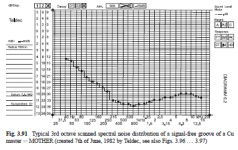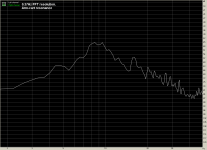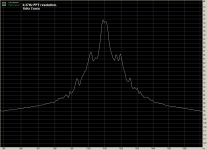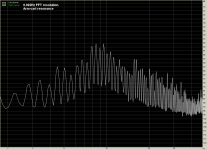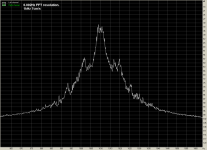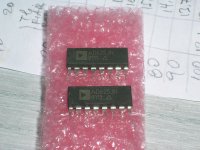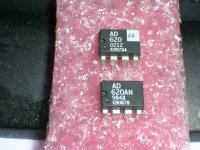you might try a G = 100 head amp some time to compare noise/sound.
I went shopping today for two affordable AD 620, 621 or 622 for building another flat head pre for the DL-103 digitising exercise.
I only found the better (but 13Euro each) AD625. I turned around my pockets and got them.

(The nice thing about them is that they provide access to the base and emitter of the input transistor and to the input of the summing amp, so in addition to use them as a flat head pre, I am tempted to work in implementing the RIAA 75us transition point across pins 1-2 &15-16 and the 318us & 3180us transition points across pins 10-11)
http://www.analog.com/media/en/technical-documentation/data-sheets/AD625.pdf
George
I went shopping today for two affordable AD 620, 621 or 622 for building another flat head pre for the DL-103 digitising exercise.
I only found the better (but 13Euro each) AD625. I turned around my pockets and got them.
(The nice thing about them is that they provide access to the base and emitter of the input transistor and to the input of the summing amp, so in addition to use them as a flat head pre, I am tempted to work in implementing the RIAA 75us transition point across pins 1-2 &15-16 and the 318us & 3180us transition points across pins 10-11)
http://www.analog.com/media/en/technical-documentation/data-sheets/AD625.pdf
George
My stash of 625's is too small to give any away, you can also make them FET input and use the input NPN's as a cascode. If you don't see it I can post a schematic.
Hi Scott,As long as the LF is resolved either would suffice, another 4X or so would fully resolve the peak. It's not just IM that I'm talking about since the system is not rigid both amplitude and phase would intermodulate in the worst case.
An interesting math exercise might be to correlate the LF activity to the sidebands on a 3k or 1k reference tone. I have a lot of raw files around but none wet played.
BTW I gave Jan some in-amps for you, I though you might try a G = 100 head amp some time to compare noise/sound.
I will redo the wet/dry tests and concentrate this time on the IM products around the 1Khz reference tone.
At the same time I will show the noise behaviour from 1Hz to 50 Hz from the same recordings to find a possible correlation.
The 1Khz reference on my LP was never played wet, making it possible to compare the real difference.
I will use an FFT twice as long to get an even finer resolution of 0.75 Hz.
Since this will be outside the scope of this thread, I will publish the results in a new thread.
Concerning the amps that you gave to Jan, I will send you a PM to follow up.
Hans
Though there is huge c 10Hz baseband signal transponded by the cartridge, this does not amplitude modulate signal - rather it is simply superposed. So one does not see artifacts of AM modulation - rather those of FM.
What about modulation of the VTA/SRA?
The LF spectrum plot is attached below. There's about a c 12dB reduction in amplitude of the cart-arm resonant response in favour of wet playback. This is thoroughly typical IME, and reconfirms my own results and those of 3rd parties. There can be no doubt of this phenomenum.
LD
Interesting. We have discussed damping before such as the shure V15 brush or Townsend trough. I wonder if these show the same noise reduction or are they too far removed from the tip action? If we accept the stick-slip model then I can see how damping the system resonant frequency wherever it is done can help, but possibly not as much as having the stylus sloshing through a damping fluid
I will redo the wet/dry tests and concentrate this time on the IM products around the 1Khz reference tone.
At the same time I will show the noise behaviour from 1Hz to 50 Hz from the same recordings to find a possible correlation.
The 1Khz reference on my LP was never played wet, making it possible to compare the real difference.
I will use an FFT twice as long to get an even finer resolution of 0.75 Hz.
Since this will be outside the scope of this thread, I will publish the results in a new thread.
Great, Hans. This time please measure and publish the friction coefficient, also please make available raw audio files in a lossless format captured at high sample rate.
It's not necessary, but harmless, to analyse extended recorded periods. I'm sure you know how to improve resolution when looking at LF bandwidth in FFT, just as I do. You should shoot for about 0.15Hz resolution when looking at the cart-arm resonance. I'm also sure we are each well capable of getting this stuff right and working out where any true differences in results might be.
I see no need for a separate thread, unless you are interested in looking at the LF FM effects of dynamic friction on headshell stability, in which case deal me in, Hans?
That friction coefficient correlates with crackle-pop noise floor is the direct issue. Strictly, you need to demonstrate you are reducing friction, either directly by measuring coefficient, or by the signature of the LF spectrum.
LD
What about modulation of the VTA/SRA?
The primary effect amounts to 'scrape' or 'rake' of the stylus along the groove, which is FM.
But yes, there is a 2nd order effect due to the cartridge being sometimes offset from 'nominal perfect position', which possibly explains somewhat lower harmonic distortion arising from wet playback, and from lower friction generally.
LD
A brand new vinyl album is silent.
You mean that a brand new vinyl album is crackle/pop free. Otherwise, regarding surface noise, “silent” is a matter of interpretation.
In Burkhard Vogel’s book The Sound of Silence - Lowest-Noise RIAA Phono-Amps: | Burkhard Vogel | Springer
chapter 3.8 is dedicated to “ Noise of Vinyl Records”. The data provided from very reliable source (Teldec) is telling.
For brand new, unused record played on a lathe, noise level:
Disks cut with Direct Metal Mastering (DMM) process : –70dBA (0dB=signal from 1kHz @ modulation velocity of 8cm/s )
Disks cut with non DMM process (lacquer) : –64dBA (0dB=signal from 1kHz @ modulation velocity of 8cm/s ).
And the noise distribution does contain the LF data, therefore, Hans no need to open another thread.
0.37 Hz FFT resolution isn’t enough to show in full glory what Scott is interested in.
George
Attachments
Interesting. We have discussed damping before such as the shure V15 brush or Townsend trough. I wonder if these show the same noise reduction or are they too far removed from the tip action? If we accept the stick-slip model then I can see how damping the system resonant frequency wherever it is done can help, but possibly not as much as having the stylus sloshing through a damping fluid
Yes, whatever method used to stabilise headshell motion has the same effect. Damping controls Q of arm resonance, whereas avoiding stimulus controls amplitude. They can work together too. Reduced friction, eg wet playback, doesn't affect Q (damping) according to lf spectrum measurement, but it does reduce amplitude. Presumption is reduced stimulus.
There isn't notable mechanical damping in wet playback, perhaps that's counter-intuitive but I think it's evident. Q of the mechanical resonance doesn't change, see the shape of the plots I posted a few posts ago! It's all about stimulus, amplitude is reduced.
LF spectrum doesn't affect audioband noise floor per se. It's just a marker for friction, which does affect it!
LD
For brand new, unused record played on a lathe, noise level:
Disks cut with Direct Metal Mastering (DMM) process : –70dBA (0dB=signal from 1kHz @ modulation velocity of 8cm/s )
0.37 Hz FFT resolution isn’t enough to show in full glory what Scott is interested in.
George
I got the same ~70dB off of some DMM disks via my own measurements. I like your 4th plot the sidebands are all harmonic not noise.
I like your 4th plot the sidebands are all harmonic not noise.
Yes you can nicely see FM sidebands associated with c 10Hz cart-arm resonance. Bruel & Kjaer, who made spectrum analysers back in the day, published an article based on it.
All causes of pitch instability show up as FM sidebands. Just listen to a vinyl 3kHz test tone, versus a 3kHz tone played on a CD..........!
Roughly, in order of contribution, it goes eccentricity, warp, cart-arm resonance, motor cogging, tonearm resonance IME. With enough resolution each shows up as distinct sideband pairs because each is repetitive at its own frequency.
It's FM 'noise', only audible because it modulates programme material. Still strictly noise though, but not as we think of noise in the classic sense perhaps.
PS: at risk of another arrow in Custer's head, 0dB in those plots has a reference level of 7cm/s..........
I think one interesting crux point is whether reduced friction might improve playback noise floor beyond well respected limits. If surface flatness of the master is limiting, probably not I would guess. If playback friction is limiting, then perhaps. Interesting.
LD
Last edited:
I must admit to thinking of warp as a solved problem so tend to ignore that. Motor cogging effects do interest me partly because its an interesting problem but mainly because you can setup a test rig without needing a record so you can look at the actual issue rather than the end modulation problem. That and I have a pile of DD turntable motors lying around to play with 🙂
I was thrown for a second as the AD website lists the most expensive package first at $185 and wondered how you had found them so cheap. Lesson of the day, scroll to the bottom!I went shopping today for two affordable AD 620, 621 or 622 for building another flat head pre for the DL-103 digitising exercise.
I only found the better (but 13Euro each) AD625. I turned around my pockets and got them.
Yes you can nicely see FM sidebands associated with c 10Hz cart-arm resonance. Bruel & Kjaer, who made spectrum analysers back in the day, published an article based on it.
Audible Effects of Mechanical Resonances in Turntables - Bruel & Kjaer 1977
http://www.cieri.net/Documenti/Misu...esonances in Turntables (AN17-233 - 1977).pdf
Page 9 in particular as to sidebands.
LD
Audible Effects of Mechanical Resonances in Turntables - Bruel & Kjaer 1977
http://www.cieri.net/Documenti/Misu...esonances in Turntables (AN17-233 - 1977).pdf
Page 9 in particular as to sidebands.
LD
I would like to see an analysis that includes both magnitude and phase of the sidebands. With some carts the change of SRA causes high frequency loss which is AM on top of the FM. Just curious about the relative magnitudes of the effects. When you read all this stuff the folks chasing .0001% distortion and nsecs of PIM seem really silly.
http://www.analogplanet.com/images/512MFVTA_article.pdf
Bill, this is what I purchased. I hope they are genuine
George
You'll know soon enough. 😉 If they're fake it will have to be a different die and it simply won't work. The chance of fakes on this one are very low. The 620 OTOH has known fakes out there that have been returned by customers for FA.
The 620 OTOH has known fakes out there that have been returned by customers for FA.
Speaking of which.
Searching in my parts bins I found these two (together with two metal canned LM394).
If I dig a bit more I may hit gold
George
Attachments
- Home
- Source & Line
- Analogue Source
- Reducing Record Surface Noise - I want to know all Approaches
